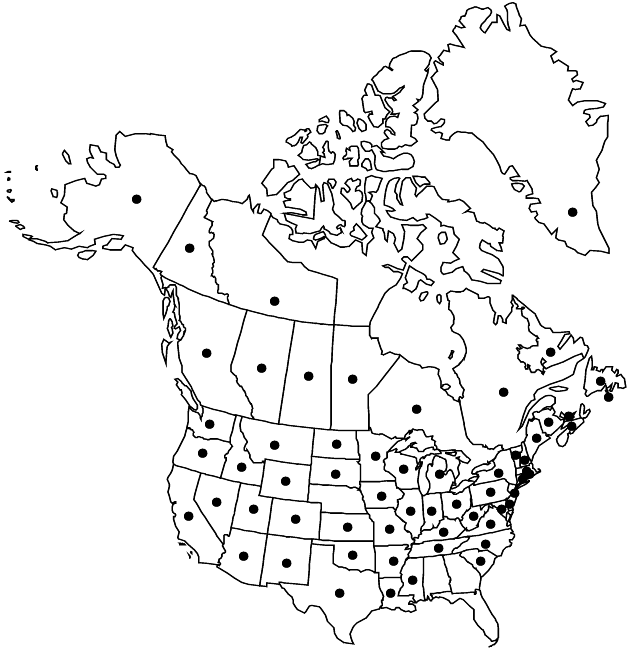Matricaria discoidea
in A. P. de Candolle and A. L. P. P. de Candolle, Prodr. 6: 50. 1838.
Annuals, (1–)4–40(–50) cm; aromatic (pineapple odor when bruised). Stems 1–10+, usually erect or ascending, sometimes decumbent, branched from bases. Leaf blades (5–)10–65(–85) × 2–20 mm. Heads discoid, (1–)4–50(–300), usually borne singly, sometimes in open, corymbiform arrays. Peduncles 2–25(–30) mm (sometimes villous near heads). Involucres 2.5–3.8 mm. Phyllaries 29–47+ in 3 series, margins mostly entire. Receptacles 2.5–7.5 mm, ± acute or obtuse. Ray florets 0. Discs hemispheric to broadly ovoid, 4–7(–11) × 4–7.5(–10) mm. Disc florets 125–535+; corollas greenish yellow, 1.1–1.3 mm (± glandular), lobes 4(–5). Cypselae pale brown to tan, ± cylindric-obconic (asymmetric, abaxially ± gibbous distally), 1.15–1.5 mm, ribs white (lateral 2 each with reddish brown mucilage gland along ± entire length, glands sometimes distally expanded, abaxial 1–2 weak, sometimes each with elongate mucilaginous gland), faces not glandular; pappi coroniform, entire. 2n = 18. [as M. matricarioides]
Phenology: Flowering early summer–fall.
Habitat: Open areas, bare disturbed areas and rural or urban waste grounds, sometimes alkaline, roadsides, railroads, footpaths, cultivated and abandoned fields and gardens, irrigation ditches, stream banks, sandbars
Elevation: 0–2700 m
Distribution

Greenland, St. Pierre and Miquelon, Alta., B.C., Man., N.B., Nfld. and Labr., N.W.T., N.S., Ont., P.E.I., Que., Sask., Yukon, Alaska, Ariz., Ark., Calif., Colo., Conn., Del., Idaho, Ill., Ind., Iowa, Kans., Ky., La., Maine, Md., Mass., Mich., Minn., Miss., Mo., Mont., Nev., N.H., N.J., N.Mex., N.Y., N.C., N.Dak., Ohio, Okla., Oreg., Pa., R.I., S.C., S.Dak., Tenn., Tex., Utah, Vt., Va., Wash., W.Va., Wis., Wyo., introduced in Eurasia, Australia.
Discussion
Matricaria discoidea has been used as a medicinal and aromatic plant by Native American tribes (D. E. Moerman 1998). It also is considered a weed, and it is resistant to a photosystem II inhibitor herbicide in the United Kingdom (www.weedscience.org). It is a northwestern North American native that has spread to eastern and northern North America and elsewhere (E. McClintock 1993b; E. G. Voss 1972–1996, vol. 3; A. Cronquist 1994). NatureServe (www.natureserve.org) and Natural Resources Conservation Service (plants.usda.gov) erroneously present M. discoidea as introduced on the continent. Its natural habitat is ill-defined because the species has become ruderal even in its native range. For discussion of the nomenclature of this taxon, see S. Rauschert (1974); K. N. Gandhi and R. D. Thomas (1991); Cronquist; and Voss.
“Matricaria matricarioides (Lessing) Porter” cannot be applied to the American taxon; M. matricarioides was originally published as Artemisia matricarioides Lessing, a new name for Tanacetum pauciflorum Richardson (see S. Rauschert 1974), itself a synonym of T. huronense Nuttall. W. Greuter (pers. comm.), who accepts M. discodea, considers Rauschert’s treating Artemisia matricarioides as homotypic with T. pauciflorum as equivalent to a lectotype designation.
Selected References
None.